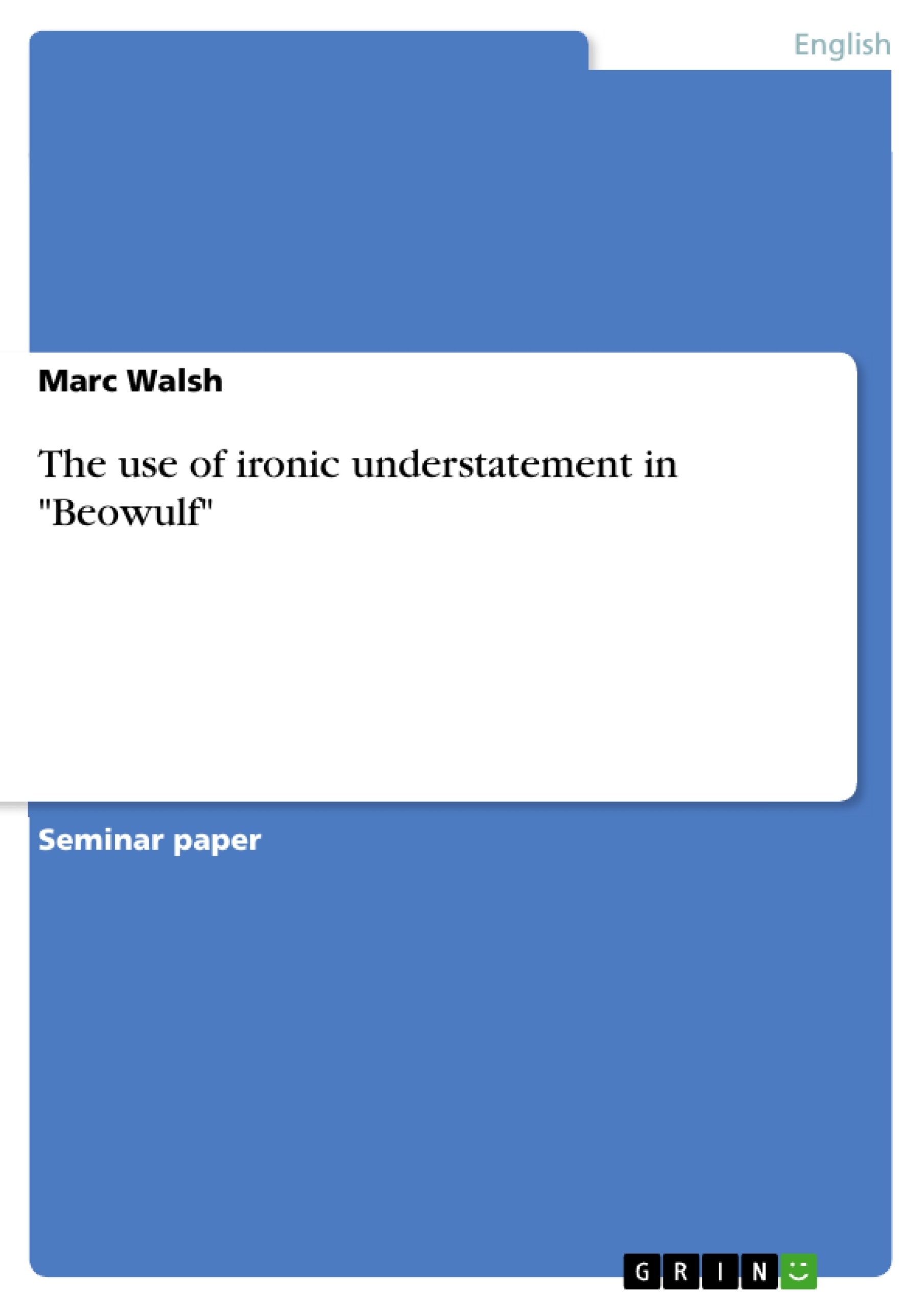This paper will describe the use of litotes and meiosis in "Beowulf", discuss the functions that have been ascribed to these linguistic features and consider why it has proven problematic to assign a specific function to understatement in the poem.
Several commentators have identified litotes, ironic understatement and negation as characteristic features of Old English poetry. Patterson (2000, 135) states that litotes is the 'characteristic mode of "Beowulf"'. Mitchell and Robinson (2012, 281) in a footnote to "The Wanderer", refer to 'the Anglo-Saxons' predilection for understatement', while Bracher (1937), in an early study of understatement in Old English Poetry, describes its use as 'frequent' and 'striking'. In the same study Bracher suggests that Albert Tolman may have been the first to identify this feature in Old English poetry, when he asserted that 'the rhetorical device known as "denying the opposite" is more frequent in A.-S. than in later English poetry' (Tolman, 1887).
Bracher (1937) finds that understatement occurs in Beowulf with a ratio of one occurrence per 34 lines and that this ratio is exceeded in several other poems, up to a ratio of one occurrence per 17 lines in "The Riming Poem". Bracher (1937) cites this high occurrence of understatement, along with its rarity in prose, as evidence that it was a characteristic linguistic feature of Old English poetry. Bracher also points out that in the rare occurrences where it is possible to compare prose and poetic versions of the same material, understatement is restricted to the poetry.
Table of Contents
- The Use of Ironic Understatement in Beowulf
Objectives and Key Themes
This paper aims to analyze the use of litotes and meiosis (ironic understatement) in the epic poem Beowulf, exploring their functions and the challenges in assigning a definitive purpose to this literary device within the poem's context.
- The frequency and prevalence of understatement in Old English poetry.
- The linguistic mechanisms used to create understatement in Beowulf (negation, prefixes, etc.).
- The contrast between understatement and other stylistic features in Beowulf (lengthy speeches, variation, hyperbole).
- Potential functions of understatement in Beowulf (rhetorical effect, humor).
- Comparison of audience reception of understatement in Old English versus modern contexts.
Chapter Summaries
The Use of Ironic Understatement in Beowulf: This chapter delves into the pervasive use of litotes and meiosis in Beowulf, examining scholarly interpretations of their function. It highlights the high frequency of understatement in Old English poetry compared to prose, supported by statistical analysis from various scholars like Bracher. The study explores different methods employed to achieve understatement, including negation of verbs and adjectives, as well as the use of words like "lyt" and "fea." The chapter further examines how context is crucial in identifying understatement, differentiating between factual negatives and instances of true litotes. It also discusses the use of negative prefixes like "un-", noting that their meaning isn't always inherently understated and relies on contextual understanding. The analysis lays the groundwork for investigating why the poet might have employed this specific rhetorical strategy.
Keywords
Beowulf, Old English poetry, litotes, meiosis, ironic understatement, negation, rhetorical devices, hyperbole, variation, Anglo-Saxon literature, stylistic analysis, literary function, audience response, humor.
Frequently Asked Questions: Analysis of Ironic Understatement in Beowulf
What is the main focus of this academic paper?
The paper analyzes the use of litotes and meiosis (ironic understatement) in the epic poem Beowulf. It explores the frequency, linguistic mechanisms, contrasting stylistic features, potential functions (rhetorical effect, humor), and audience reception of this literary device in both Old English and modern contexts.
What are the key objectives of the research?
The research aims to investigate the prevalence of understatement in Old English poetry, identify the linguistic tools used to create understatement in Beowulf (e.g., negation, prefixes), contrast understatement with other stylistic features (e.g., lengthy speeches, hyperbole), explore the possible functions of understatement within the poem, and compare audience reception across different time periods.
What specific linguistic aspects are examined in the paper?
The paper examines the use of negation in verbs and adjectives, the use of words like "lyt" and "fea," and the role of negative prefixes such as "un-" in creating understatement. It emphasizes the importance of contextual understanding in differentiating factual negatives from true instances of litotes.
How does the paper approach the analysis of understatement?
The analysis involves examining the frequency of understatement in Beowulf and comparing it to the frequency in other Old English poetry. It also considers the context in which understatement is used and explores potential reasons why the poet employed this rhetorical strategy.
What are the key themes explored in the analysis of Beowulf?
Key themes include the frequency and prevalence of understatement in Old English poetry, the linguistic mechanisms employed to achieve understatement, the contrast between understatement and other stylistic features, the potential functions of understatement (rhetorical effect, humor), and the comparison of audience reception across time periods.
What are the keywords associated with this research?
Beowulf, Old English poetry, litotes, meiosis, ironic understatement, negation, rhetorical devices, hyperbole, variation, Anglo-Saxon literature, stylistic analysis, literary function, audience response, humor.
What is included in the chapter summary section?
The chapter summary provides a detailed overview of the analysis of ironic understatement in Beowulf, highlighting the examination of scholarly interpretations, statistical analysis of understatement frequency, exploration of linguistic mechanisms, contextual analysis of understatement, and discussion of the poet's potential motivations for using this rhetorical device.
- Quote paper
- Marc Walsh (Author), 2015, The use of ironic understatement in "Beowulf", Munich, GRIN Verlag, https://www.grin.com/document/345580




